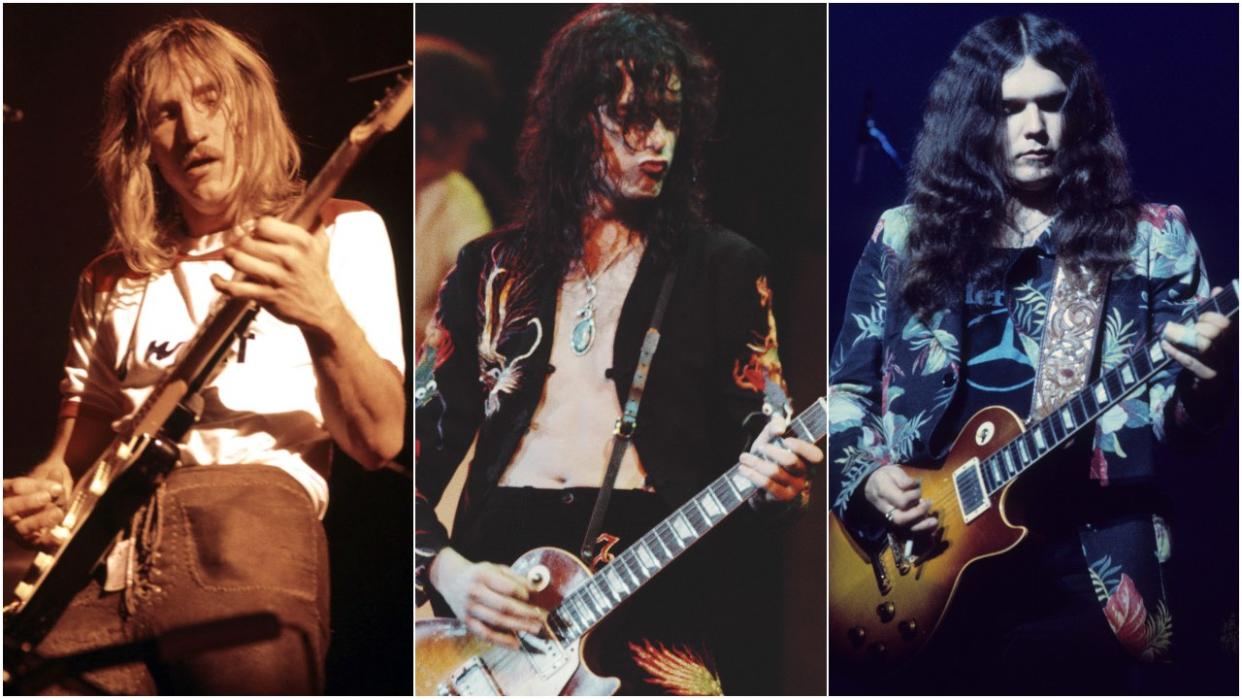The 10 greatest slide guitar moments in rock

- Oops!Something went wrong.Please try again later.
- Oops!Something went wrong.Please try again later.
- Oops!Something went wrong.Please try again later.
In a genre defined by epic riffs and flamethrowing solos, the slide guitar stands as a howling testament to raw, unbridled emotion. It's not just a technique; it's a wild, soul-stirring cry that cuts through the smog of standard chord progressions and generic fretwork. Playing with a slide is less about speed or precision and more of a showcase of pure, unadulterated feel. Here are the ten best uses of slide guitar in classic rock:

10. Johnny Winter – Highway 61 Revisited (Second Winter, 1969)
Johnny Winter picked up the axe at age 11 and began blowing minds with his incendiary fretwork shortly thereafter. When it came to slide guitar, he didn’t need a fancy ceramic or glass slide to get the job done; Johnny used one that he cut from a metal pipe that he bought from a plumbing supply store. His immense slide talents are all on display here, as he transform’s Bob Dylan’s original into a roaring blues juggernaut.
9. John Lennon – How Do You Sleep? (Imagine, 1971)
On this thinly-veiled takedown of Paul McCartney, John Lennon invited fellow ex-Beatle George Harrison to add a 35-second slide guitar solo that absolutely smokes. Though Harrison’s own My Sweet Lord might spring to mind as a more immediate example of his use of slide, his performance here is superlative; a fiery testament to Harrison’s technical genius and creative brilliance that transcends Lennon’s lyrical bitterness, emerging as a moment of devastating beauty.
8. Crosby, Stills, Nash & Young – Teach Your Children (Déjà Vu, 1970)
Jerry Garcia and the Grateful Dead were recording American Beauty in the studio next door when CSNY asked Garcia if he’d play pedal steel on the track. Garcia agreed and recorded two takes, the first of which appears on the album. His delicate, bluegrass-tinged solo arrests without ever overshadowing the song’s softer textures. Incredibly, Garcia had only learned the instrument a couple of months before recording this track.
7. Eagles – Victim Of Love (Hotel California, 1976)
Attempting to move away from their country rock roots, this stomping, mid-tempo rocker features Don Felder on lead guitar and Joe Walsh delivering a slide guitar showcase that rips through the vocal harmonies with a savage grace. His solo, brief but utterly searing, brilliantly encapsulates a “less is more” approach. From that first, slashing glissando, Walsh’s work screams with an intensity that’s both cutting and captivating.
6. George Thorogood & The Destroyers – Bad To The Bone (Bad To The Bone, 1982)
George Thorogood’s slide work here is a declaration of sheer bad-assery, a snarling, spitting embodiment of blues rock’s renegade spirit. What makes this performance so compelling is how punchy and directly he plays, emanating a bluesy and distinctly rhythmic quality that dovetails perfectly into the track’s swaggering attitude. The slide he uses is a homemade copper number that gives his Gibson ES-125 his trademark “honky” tone.
5. Jackson Browne – Running On Empty (Running On Empty, 1977)
David Lindley plays with a steel slide on a lap steel, creating a clear, bell-like tone that intensifies the track’s reflective mood. He follows the vocal lines but his part is more than musical accompaniment, it’s the soul of the song. Lindley’s smooth, sustained notes and subtle vibrato add layers of emotional depth that, in the heights of his solo, feel like bright rays of sunshine breaking through storm clouds.
4. Led Zeppelin – In My Time of Dying (Physical Graffiti, 1975)
Jimmy Page's slide in this track is a force of nature that showcases the guitarist’s experimental vision, employing a range of tunings and different slide materials to create different tonal qualities. His driving slide riffs and use of bottleneck techniques add a cutting, bluesy edge while his control over feedback and sustain adds to the song’s exhilarating tension. A primordial scream caught somewhere between the converging realms of life and death.
3. Derek and the Dominos – Layla (Layla And Other Assorted Love Songs, 1972)
Duane Allman himself used open E tuning for his enduring contribution to this feast of guitar virtuosity. Allman and Eric Clapton layered track after track of riffs and leads that build up to the song’s majestic coda, with Allman unleashing a skyscraping solo and Clapton adding a much-overlooked countermelody beneath. A smouldering testament to the otherworldly chemistry between two of rock’s most important shredders at the time.
2. ZZ Top – Tush (1975, Fandango!)
Like last call in a boozy backwoods roadhouse, the slide in Tush is wild, sleazy and carefree. Billy Gibbons' guitar moans and wails, a frenzied beast unleashed. His aggressive technique here is dominated by rapid slides up and down the neck, with a gritty, overdriven tone that cuts through the mix like a two-by-four through a plate glass window. As bassist Dusty Hill and drummer Frank Beard piledrive their way through a twelve-bar blues progression, Gibbons delivers a feverish, sweat-soaked sermon from the Church of Electric Mayhem.
1. Lynyrd Skynyrd – Free Bird (Pronounced 'Lĕh-'nérd 'Skin-'nérd, 1974)
Despite popular notions to the contrary, there is no jamming in Lynyrd Skynyrd. Though their tracks erupt with expansive solos, Skynyrd’s various guitar parts were written as distinct melodic complements to the other instruments. Here, Gary Rossington’s slide offers a thrilling counterpoint to Allen Collins’ soulful chord progression, playing as an echo of Ronnie Van Zant’s vocals. Memorising Rossington’s opening melody is a rite of passage for all classic rock enthusiasts and fifty years after it was released, it remains one of rock’s most beloved and iconic solos.

